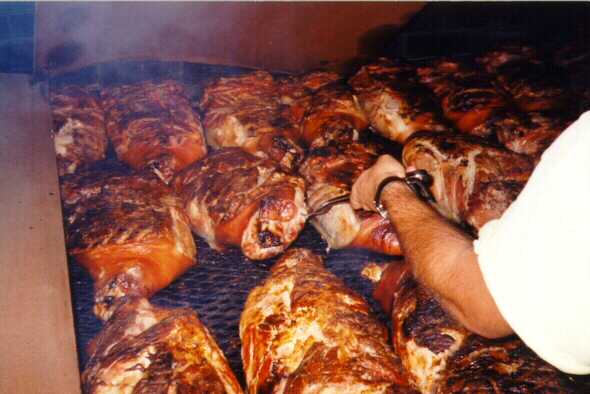|
Barbecue Techniques There are many techniques associated
with what is often referred to as America's only indigenous culinary
style: barbecuing. Here we explore these techniques ranging from cave-man to
backyard-man.
Open Pit Smoking
Cooking food over open fire pits is a technique that goes
back to the cave man. The art and science of pit smoking reached a zenith in the
days of our grandfathers, and great grandfathers. Pitmasters would use closely
guarded secrets to produce succulent results.  With a whole, skinned animal on a spit lowered into a pit layered
with rock, screening materials and selected hardwoods the pitmaster had to control the
temperature of the pit, keeping it low enough to work its magic. Meat drippings
falling on the coals below flavored the smoke which, in turn, infused the meats. With a whole, skinned animal on a spit lowered into a pit layered
with rock, screening materials and selected hardwoods the pitmaster had to control the
temperature of the pit, keeping it low enough to work its magic. Meat drippings
falling on the coals below flavored the smoke which, in turn, infused the meats.
This method is seldom used today mostly because ingenious devices
came along, which allowed the same spectacular results without the hassle of digging and
preparing the pit. Even long standing barbecue joints in the south that began by
using open pits have long since switched over to smokehouses, some using gas- or
electric-fired equipment.
Smoke Curing
Sometimes referred to as "cold smoking", curing with smoke was an important
means of preserving foods in the days before the widespread availability of refrigeration.
Smoke curing is done at low temperatures (100 degrees or less) for long periods
of time.
The resulting foods are smoked but not cooked. They require
additional cooking before they are ready to eat. This is the difference between a
barbecued pork shoulder and a cured country ham - similar processes but very different
results
Smokehouse Barbecuing
Almost all the barbecuing done today, with a few notable exceptions,
are variations of smokehouse barbecuing. Meaning that food is cooked in a closed,
vented chamber surrounded by smoke. As you'll see when investigating different types
of smokers that will seem like the only thing they have in common.
Open pits were vulnerable to the weather and required too much of
the pitmaster's time. Around the turn of the 20th century commercial BBQ joints
figured there must be a better way, and smokehouses were
invented. Brick contraptions sprung up behind the restaurants. There was space
for the fire and racks built along the inside walls that could not only hold more meat
than an open pit but was easier for the pitmaster to tend. Ingenious
devices were developed to allow controlled venting, and the fire was moved to one end of
the smokehouse while the meats were stacked at the other end. This too made things
more convenient for the pitmaster, but more importantly it marked the end of a key feature
of open pit cooking: the meat juices no longer drizzled on the hot logs below, and
the era of dry smoking was begun. smokehouses were
invented. Brick contraptions sprung up behind the restaurants. There was space
for the fire and racks built along the inside walls that could not only hold more meat
than an open pit but was easier for the pitmaster to tend. Ingenious
devices were developed to allow controlled venting, and the fire was moved to one end of
the smokehouse while the meats were stacked at the other end. This too made things
more convenient for the pitmaster, but more importantly it marked the end of a key feature
of open pit cooking: the meat juices no longer drizzled on the hot logs below, and
the era of dry smoking was begun.
Wet or Dry?
The use of additional moisture is controversial - even among
seasoned veterans of the barbecue wars. It was never an issue with open pit
barbecuing in part because the nature of the open pit makes it difficult to do, and with
the flavored, steamy smoke produced by fat drizzling on hot logs additional moisture
wasn't needed.
Smokehouse barbecuing, however, didn't have the natural moisture
produced in the open pit. Nevertheless many enthusiasts insist it isn't required
believing that barbecuing should be a dry  process. In large part it
depends a little on just what you're cooking. Traditional cuts such as briskets,
pork butts and ribs are fatty and moisture laden. Introducing moisture into the
smoking process doesn't hurt but these meats will turn out fine without it. Leaner
cuts and especially fish and chicken benefit from the additional moisture and helps
prevent them from drying out during the long cooking times in the smoker. process. In large part it
depends a little on just what you're cooking. Traditional cuts such as briskets,
pork butts and ribs are fatty and moisture laden. Introducing moisture into the
smoking process doesn't hurt but these meats will turn out fine without it. Leaner
cuts and especially fish and chicken benefit from the additional moisture and helps
prevent them from drying out during the long cooking times in the smoker.
What's most important is to ensure that the moisture inside the
smoker doesn't get hot enough to steam the meats. If guidelines for maintaining the
proper temperature inside the cooking chamber are followed, and proper
ventilation is provided, this shouldn't be a problem.
So there you have a quick introduction to real barbecuing.
Searching the internet for barbecue will take you to other sites, with more information than, as Grandma used to say, you
can shake a stick at.
Cheers,
Big Daddy |
![]() Big
Daddy's Kitchen
Big
Daddy's Kitchen